Grid-Scale Battery Energy Storage Operation in Australian Electricity Spot and Contingency Reserve Markets
Abstract
:1. Introduction
- A mathematical model for assessing battery operation in different electricity markets (i.e., energy trading, provision of frequency regulation services), considering various control strategies, is developed.
- The battery operational cost function, based on cycling degradation, is integrated into the decision-making algorithm of the battery energy storage system.
- We investigate the value of battery participation in the electricity spot market, combined with 6-s, 60-s or 5-min raise and lower contingency markets, for the Australian National Electricity Market.
- We investigate the impact of regional generation mix on the benefits of battery participation in electricity markets, by considering battery operation in different regions dominated by particular sources of generation, such as coal, gas, hydro, wind or solar.
2. The Australian Electricity Market
2.1. Energy Market
2.2. Reserve Markets
3. Grid-Scale Battery Energy Storage
3.1. The Role of Batteries in Electricity Markets
3.2. Battery Health Characteristics
- Battery-cell temperature. There is an exponential decay in battery life expectancy with increased BESS operating temperature. Extremely high temperatures can lead to the build-up of internal pressure, battery bursts and fire hazards. To prevent such events from happening, BESSs are generally equipped with climate-control systems that maintain battery-cell temperature at a constant value.
- Battery charge and discharge rate. The metric used to measure the battery discharge rate is called the ‘C’ rate, where the battery discharging at rate 1C would be fully discharged in one hour. A battery discharging at higher rates (e.g., 2C) would fully discharge faster (half an hour for 2C, quarter of an hour for 4C, etc.). Degradation occurring at lower ‘C’ rates is generally gradual, while increasing rates result in an exponential rise in degradation [34]. The discharging rate can be included as an additional cost component within the battery cost function that can be used as a metric to determine if aggressive battery operation is cost-effective in a given market environment. In practice, however, it is not recommended to operate batteries above their recommended ‘C’ ratings because the resultant temperature rise would result in additional cooling costs or increase the risk of fire.
- Battery-cycle depth of discharge. One of the most important parameters affecting battery degradation is the depth to which the batteries get discharged during each cycle of operation. The dependency between the depth of discharge (DOD) and degradation is non-linear. For example, a generic lithium-ion battery can perform around 22,000 cycles of 30% to reach its end-of-life conditions. However, if the cycle depth is increased to 80%, the battery would only perform 3000 cycles.
- Over-charge, under-charge and average state of charge. Extreme values of state of charge (SOC) can significantly damage the battery health [46]. Therefore, to avoid such events, several constraints are enforced on minimum, maximum and average values of SOC.
3.3. Degradation Cost Function
- Depth of discharge () of the considered cycle, i, is estimated.
- Life loss (associated with the cycle, i, corresponding to the % of total-cycle life reduction, is estimated. It has a dependence on and is expressed as [34]:where and are coefficients capturing the relationship between life loss and the cycle depth, which may be determined empirically for a given class of battery.
- The marginal cost of that cycle, i (), is evaluated by prorating the battery replacement cost, , to the incremental life loss:
- is battery discharge power, is battery charge power, and these are fixed for the entire interval.
- Energy is discharged/charged from the battery and can be considered to come from one or more segments of the cycle life-loss function, depending on the amount of stored energy assigned to those segments.
- Total discharge cost of a dispatch interval is minimized to ensure cycle degradation is accurately accounted for (since cycle loss is a function of DOD for a cycle, not SOC).
4. Model for Assessing the Battery Energy Storage System Operation
- —the number of time intervals, each denoted by t, included in the optimization horizon (e.g., for 24 h horizon with 5 min dispatch intervals, T = 288);
- —the number of segments, each denoted by j, in the BESS cycling cost function;
- —duration of a dispatch interval, e.g., 1/12 for a market cleared every 5 min (hours);
- —forecast price on the energy wholesale market ($/MWh);
- —forecast prices on 6 s, 60 s and 5 min raise FCAS markets ($/MWh);
- —forecast prices on 6 s, 60 s and 5 min lower FCAS markets ($/MWh);
- —charging and discharging efficiencies (%);
- —energy limits of BESS (MWh);
- —maximum amount of energy stored in cycle-depth segment j (MWh);
- —initial amount of energy stored in cycle-depth segment j of BESS at the beginning of the optimization horizon (MWh);
- —energy stored in the battery at the last interval (T) of the optimization horizon (MWh);
- —maximum charging and discharging power limits of BESS (MW)
- —discharging power of the BESS at time interval t (MW);
- —charging power of the BESS at time interval t (MW);
- —available discharging power of the BESS for reserve provision at time interval t (MW);
- —available charging power of the BESS for reserve provision at time interval t (MW);
- —the quantity of reserve power enabled for 6 s, 60 s and 5 min raise FCAS markets, respectively (MW);
- —the quantity of reserve power enabled for 6 s, 60 s and 5 min lower FCAS markets, respectively (MW);
- —binary variable equal to 1 if the BESS provides reserve at time interval t and equal to 0 otherwise;
- —binary variable equal to 1 if battery is charging and 0 otherwise;
- —energy stored in cycle-depth segment j of the BESS at time interval t (MWh);
- —charging BESS power for cycle-depth segment j at time interval t (MW)
- —discharging BESS power for cycle-depth segment j at time interval t.
5. Case Studies
5.1. Battery Description and Model Assumptions
5.2. Battery Operation Considering Different Bidding Strategies
5.3. Optimal Battery Operation in State-Based Regional Markets of the NEM
6. Conclusions
Author Contributions
Funding
Institutional Review Board Statement
Informed Consent Statement
Data Availability Statement
Acknowledgments
Conflicts of Interest
Abbreviations
| AEMO | Australian Energy Market Operator |
| BESS | Battery Energy Storage System |
| DOD | Depth of Discharge |
| FCAS | Frequency Control Ancillary Services |
| HVDC | High-Voltage Direct Current |
| NEM | National Electricity Market |
| NOB | Normal Operating Band |
| NSW | New South Wales |
| PV | Photovoltaics |
| QLD | Queensland |
| SA | South Australia |
| SOC | State of Charge |
| TAS | Tasmania |
| VIC | Victoria |
References
- Ajadi, T.; Cuming, V.; Boyle, R.; Strahan, D.; Kimmel, M.; Logan, M. Global Trends in Renewable Energy Investment 2020; Frankfurt School of Finance & Management: Frankfurt am Main, Germany, 2020. [Google Scholar]
- Gielen, D.; Boshell, F.; Saygin, D.; Bazilian, M.D.; Wagner, N.; Gorini, R. The role of renewable energy in the global energy transformation. Energy Strategy Rev. 2019, 24, 38–50. [Google Scholar] [CrossRef]
- He, G.; Chen, Q.; Kang, C.; Xia, Q.; Poolla, K. Cooperation of wind power and battery storage to provide frequency regulation in power markets. IEEE Trans. Power Syst. 2016, 32, 3559–3568. [Google Scholar] [CrossRef]
- Argyrou, M.C.; Christodoulides, P.; Kalogirou, S.A. Energy storage for electricity generation and related processes: Technologies appraisal and grid scale applications. Renew. Sustain. Energy Rev. 2018, 94, 804–821. [Google Scholar] [CrossRef]
- Chen, T.; Jin, Y.; Lv, H.; Yang, A.; Liu, M.; Chen, B.; Xie, Y.; Chen, Q. Applications of lithium-ion batteries in grid-scale energy storage systems. Trans. Tianjin Univ. 2020, 26, 208–217. [Google Scholar] [CrossRef] [Green Version]
- McKeon, B.B.; Furukawa, J.; Fenstermacher, S. Advanced lead–acid batteries and the development of grid-scale energy storage systems. Proc. IEEE 2014, 102, 951–963. [Google Scholar] [CrossRef]
- Perry, M.L.; Weber, A.Z. Advanced redox-flow batteries: A perspective. J. Electrochem. Soc. 2015, 163, A5064. [Google Scholar] [CrossRef]
- Andriollo, M.; Benato, R.; Sessa, S.D.; di Pietro, N.; Hirai, N.; Nakanishi, Y.; Senatore, E. Energy intensive electrochemical storage in Italy: 34.8 MW sodium–sulphur secondary cells. J. Energy Storage 2016, 5, 146–155. [Google Scholar] [CrossRef]
- Sessa, S.D.; Palone, F.; Necci, A.; Benato, R. Sodium-nickel chloride battery experimental transient modelling for energy stationary storage. J. Energy Storage 2017, 9, 40–46. [Google Scholar] [CrossRef]
- Bowen, T.; Chernyakhovskiy, I.; Denholm, P.L. Grid-Scale Battery Storage: Frequently Asked Questions; National Renewable Energy Laboratory (NREL): Golden, CO, USA, 2019. [Google Scholar]
- Pusceddu, E.; Zakeri, B.; Gissey, G.C. Synergies between energy arbitrage and fast frequency response for battery energy storage systems. Appl. Energy 2021, 283, 116274. [Google Scholar] [CrossRef]
- Stroe, D.-I.; Knap, V.; Swierczynski, M.; Stroe, A.-I.; Teodorescu, R. Suggested operation of grid-connected lithium-ion battery energy storage system for primary frequency regulation: Lifetime perspective. In Proceedings of the 2015 IEEE Energy Conversion Congress and Exposition (ECCE), Boulder, CO, USA, 13–15 May 2015; pp. 1105–1111. [Google Scholar]
- Krata, J.; Saha, T.K. Real-time coordinated voltage support with battery energy storage in a distribution grid equipped with medium-scale PV generation. IEEE Trans. Smart Grid 2018, 10, 3486–3497. [Google Scholar] [CrossRef]
- Szablicki, M.; Rzepka, P.; Sowa, P.; Halinka, A. Energy Storages as Synthetic Inertia Source in Power Systems. In Proceedings of the 2018 IEEE 38th Central America and Panama Convention (CONCAPAN XXXVIII), San Salvador, El Salvador, 7–9 November 2018; pp. 1–6. [Google Scholar]
- Benato, R.; Bruno, G.; Palone, F.; Polito, R.M.; Rebolini, M. Large-scale electrochemical energy storage in high voltage grids: Overview of the Italian experience. Energies 2017, 10, 108. [Google Scholar] [CrossRef]
- Pimm, A.J.; Cockerill, T.T.; Taylor, P.G. The potential for peak shaving on low voltage distribution networks using electricity storage. J. Energy Storage 2018, 16, 231–242. [Google Scholar] [CrossRef]
- Lamsal, D.; Sreeram, V.; Mishra, Y.; Kumar, D. Smoothing control strategy of wind and photovoltaic output power fluctuation by considering the state of health of battery energy storage system. IET Renew. Power Gener. 2019, 13, 578–586. [Google Scholar] [CrossRef]
- Barra, P.; de Carvalho, W.; Menezes, T.; Fernandes, R.; Coury, D. A review on wind power smoothing using high-power energy storage systems. Renew. Sustain. Energy Rev. 2020, 137, 110455. [Google Scholar] [CrossRef]
- Karandeh, R.; Prendergast, W.; Cecchi, V. Optimal scheduling of battery energy storage systems for solar power smoothing. In Proceedings of the 2019 SoutheastCon, Huntsville, AL, USA, 11–14 April 2019; pp. 1–6. [Google Scholar]
- Semshchikov, E.; Negnevitsky, M.; Hamilton, J.; Wang, X. Cost-efficient strategy for high renewable energy penetration in isolated power systems. IEEE Trans. Power Syst. 2020, 35, 3719–3728. [Google Scholar] [CrossRef]
- Eyer, J.M. Electric Utility Transmission and Distribution Upgrade Deferral Benefits from Modular Electricity Storage: A Study for the Doe Energy Storage Systems Program; Sandia National Laboratories: Livermore, CA, USA, 2009. [Google Scholar]
- Rocabert, J.; Capó-Misut, R.; Muñoz-Aguilar, R.S.; Candela, J.I.; Rodriguez, P. Control of energy storage system integrating electrochemical batteries and supercapacitors for grid-connected applications. IEEE Trans. Ind. Appl. 2018, 55, 1853–1862. [Google Scholar] [CrossRef]
- He, G.; Chen, Q.; Kang, C.; Pinson, P.; Xia, Q. Optimal bidding strategy of battery storage in power markets considering performance-based regulation and battery cycle life. IEEE Trans. Smart Grid 2015, 7, 2359–2367. [Google Scholar] [CrossRef] [Green Version]
- Hittinger, E.; Whitacre, J.; Apt, J. Compensating for wind variability using co-located natural gas generation and energy storage. Energy Syst. 2010, 1, 417–439. [Google Scholar] [CrossRef]
- Xiao, D.; AlAshery, M.K.; Qiao, W. Optimal Price-Maker Trading Strategy of Wind Power Producer using Virtual Bidding. J. Mod. Power Syst. Clean Energy 2021, 1–13. [Google Scholar] [CrossRef]
- Xiao, D.; do Prado, J.C.; Qiao, W. Optimal joint demand and virtual bidding for a strategic retailer in the short-term electricity market. Electr. Power Syst. Res. 2021, 190, 106855. [Google Scholar] [CrossRef]
- Xiao, D.; Qiao, W. A hybrid electricity price scenario generation method for stochastic virtual bidding in the electricity market. CSEE J. Power Energy Syst. 2021, 1–9. [Google Scholar] [CrossRef]
- Günter, N.; Marinopoulos, A. Energy storage for grid services and applications: Classification, market review, metrics, and methodology for evaluation of deployment cases. J. Energy Storage 2016, 8, 226–234. [Google Scholar] [CrossRef]
- Australian Energy Market Operator. 2020 Integrated System Plan for the National Electricity Market; AEMO: Melbourne, Australia, 2020. [Google Scholar]
- Aurecon. Hornsdale Power Reserve—Year 2 Technical and Market Impact Case Study; Aurecon: Melbourne, Australia, 2020. [Google Scholar]
- Benato, R.; Sessa, S.D.; Musio, M.; Palone, F.; Polito, R.M. Italian experience on electrical storage ageing for primary frequency regulation. Energies 2018, 11, 2087. [Google Scholar] [CrossRef] [Green Version]
- Yan, G.; Liu, D.; Li, J.; Mu, G. A cost accounting method of the Li-ion battery energy storage system for frequency regulation considering the effect of life degradation. Prot. Control. Mod. Power Syst. 2018, 3, 1–9. [Google Scholar] [CrossRef]
- Mohsenian-Rad, H. Optimal bidding, scheduling, and deployment of battery systems in California day-ahead energy market. IEEE Trans. Power Syst. 2015, 31, 442–453. [Google Scholar] [CrossRef] [Green Version]
- Padmanabhan, N.; Ahmed, M.; Bhattacharya, K. Battery energy storage systems in energy and reserve markets. IEEE Trans. Power Syst. 2019, 35, 215–226. [Google Scholar] [CrossRef]
- Australian Energy Market Operator. An Introduction to Australia’s National Electricity Market; AEMO: Melbourne, Australia, 2010. [Google Scholar]
- Australian Energy Market Operator. The National Electricity Market; Fact Sheet; AEMO: Melbourne, Australia, 2020. [Google Scholar]
- Rai, A.; Nelson, T. Australia’s National Electricity Market after Twenty Years. Aust. Econ. Rev. 2020, 53, 165–182. [Google Scholar] [CrossRef]
- Blakers, A.; Stocks, M.; Lu, B.; Cheng, C. The observed cost of high penetration solar and wind electricity. Energy 2021, 233, 121150. [Google Scholar] [CrossRef]
- Australian Energy Market Commission. Reserve Services in the National Electricity Market; AEMO: Melbourne, Australia, 2021. [Google Scholar]
- Australian Energy Market Operator. Five-Minute Settlement: High Level Design; Technical Report; AEMO: Melbourne, Australia, 2017. [Google Scholar]
- Australian Energy Market Operator. Guide to Ancillary Services in the National Electricity Market; Australian Energy Market Operator: Melbourne, Australia, 2015. [Google Scholar]
- Australian Energy Market Operator. Market Ancillary Service Specification; AEMO: Melbourne, Australia, 2020. [Google Scholar]
- Thorncraft, S.; Outhred, H. Experience with market-based ancillary services in the Australian national electricity market. In Proceedings of the 2007 IEEE Power Engineering Society General Meeting, Tampa, FL, USA, 24–28 June 2007; pp. 1–9. [Google Scholar]
- Australian Energy Market Operator. AEMO Virtual Power Plant Demonstration: Knowledge Sharing Report #1; AEMO: Melbourne, Australia, 2020. [Google Scholar]
- Hesse, H.C.; Schimpe, M.; Kucevic, D.; Jossen, A. Lithium-ion battery storage for the grid—A review of stationary battery storage system design tailored for applications in modern power grids. Energies 2017, 10, 2107. [Google Scholar] [CrossRef] [Green Version]
- Vetter, J.; Novák, P.; Wagner, M.R.; Veit, C.; Möller, K.-C.; Besenhard, J.; Winter, M.; Wohlfahrt-Mehrens, M.; Vogler, C.; Hammouche, A. Ageing mechanisms in lithium-ion batteries. J. Power Sources 2005, 147, 269–281. [Google Scholar] [CrossRef]
- Xu, B.; Zhao, J.; Zheng, T.; Litvinov, E.; Kirschen, D.S. Factoring the cycle aging cost of batteries participating in electricity markets. IEEE Trans. Power Syst. 2017, 33, 2248–2259. [Google Scholar] [CrossRef] [Green Version]
- Xu, B.; Oudalov, A.; Ulbig, A.; Andersson, G.; Kirschen, D.S. Modeling of lithium-ion battery degradation for cell life assessment. IEEE Trans. Smart Grid 2016, 9, 1131–1140. [Google Scholar] [CrossRef]
- LLC Gurobi Optimization. Gurobi Optimizer Reference Manual; Gurobi Optimization: Beaverton, OR, USA, 2020. [Google Scholar]
- Market Data NEMWEB, Australian Energy Market Operator: AEMO. Available online: https://aemo.com.au/energy-systems/electricity/national-electricity-market-nem/data-nem/market-data-nemweb (accessed on 30 September 2021).
- Wholesale Statistics, Australian Energy Regulator: AER. Available online: https://www.aer.gov.au/wholesale-markets/wholesale-statistics (accessed on 17 August 2021).




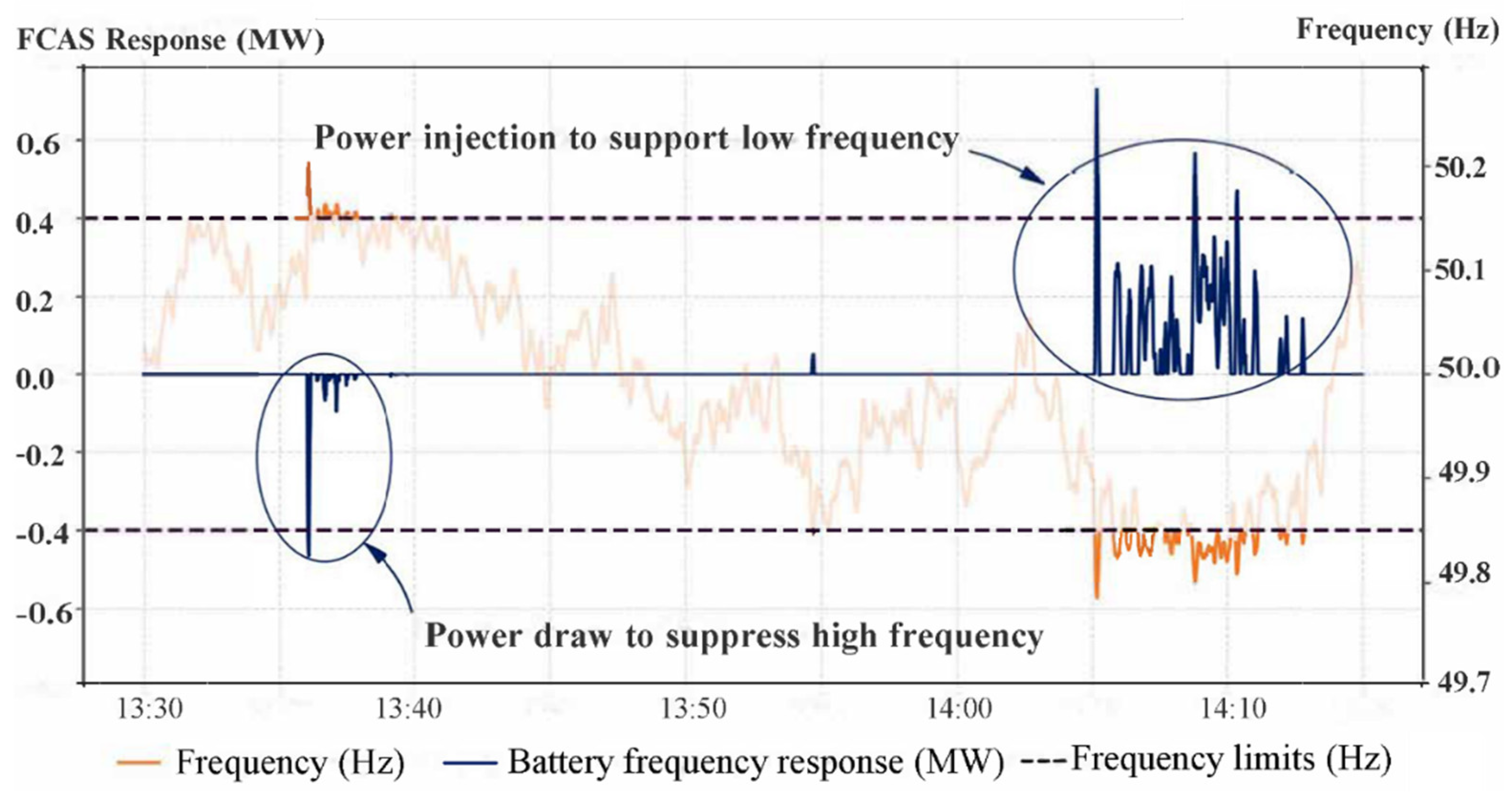
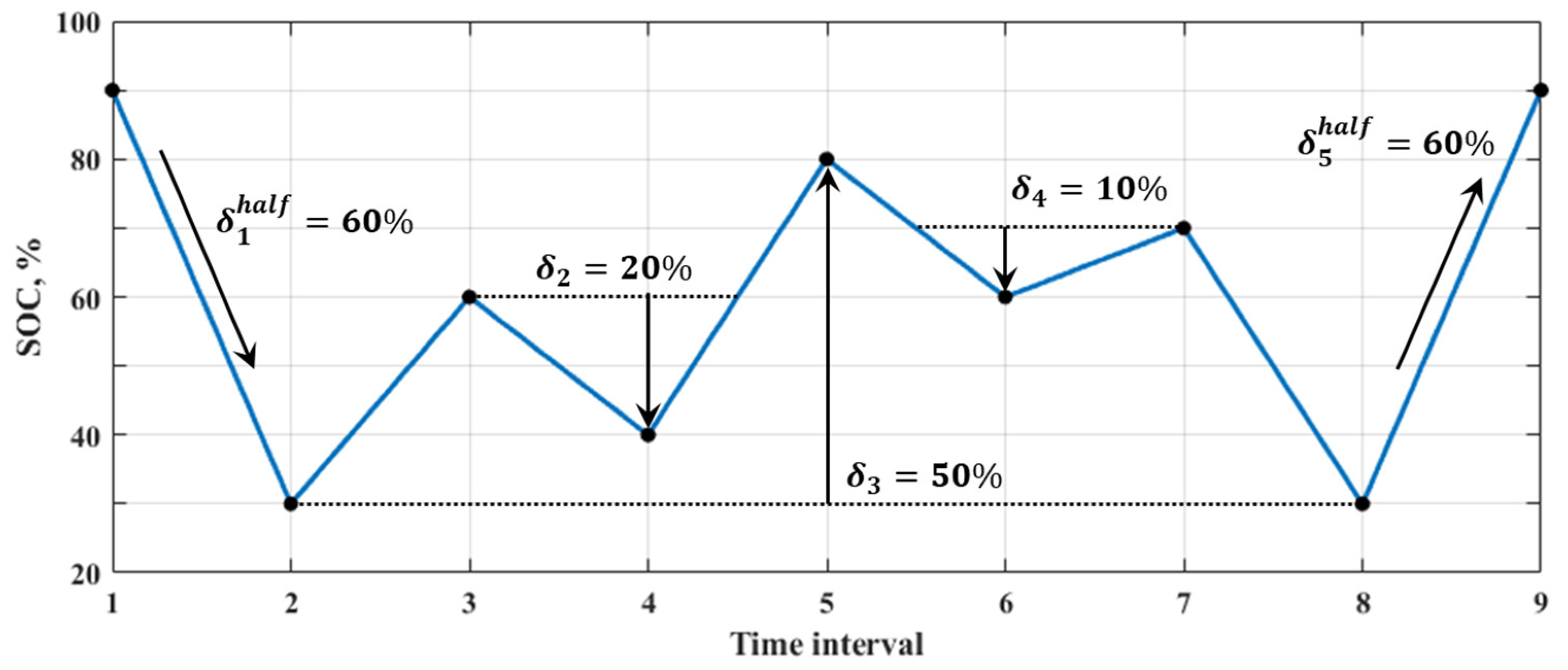


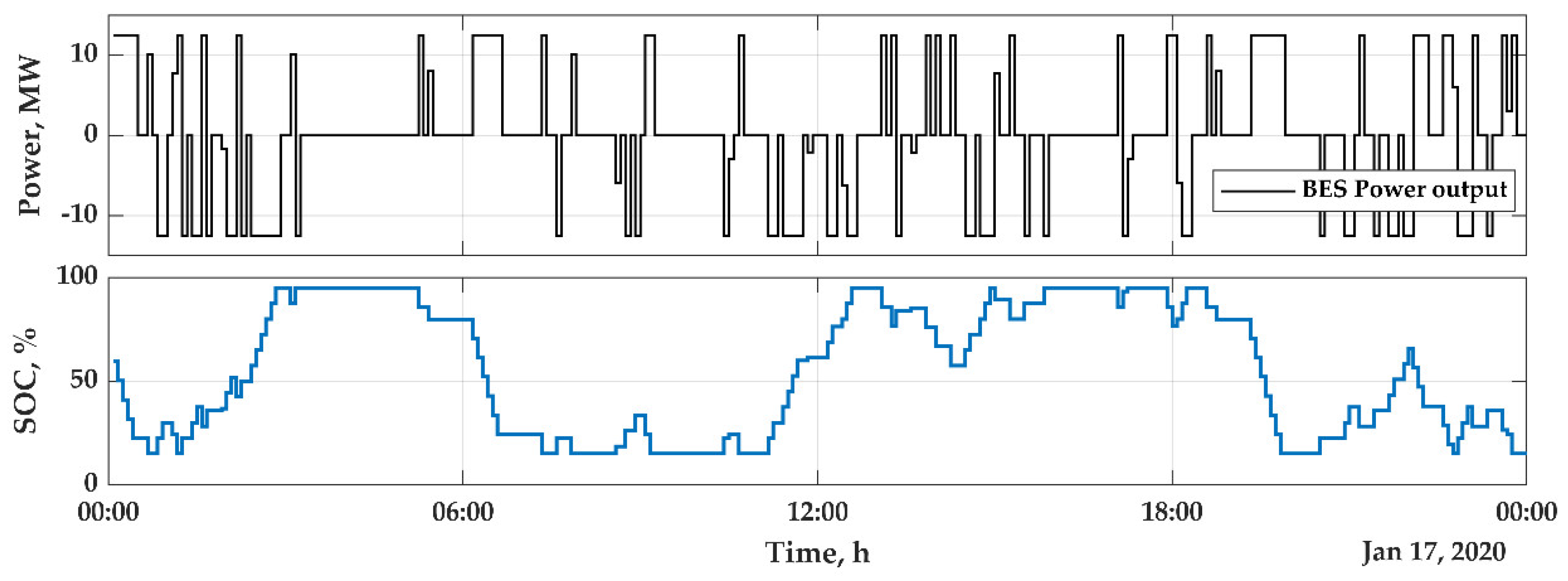
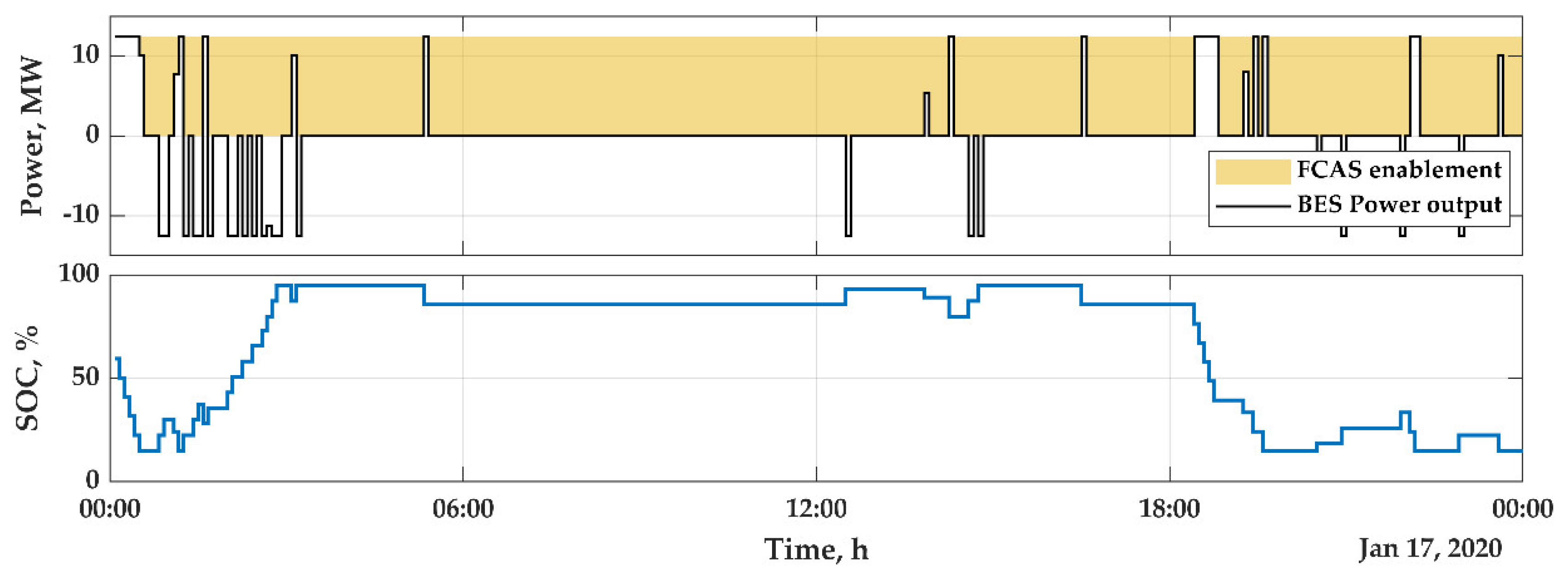
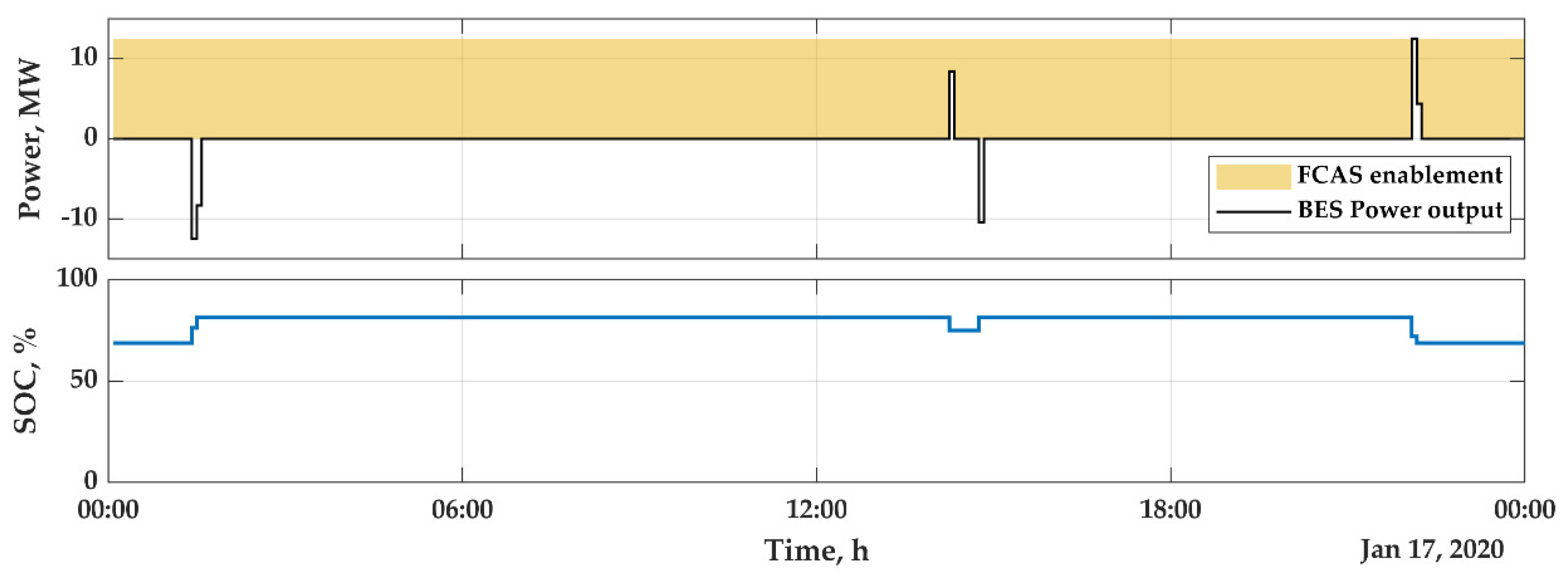

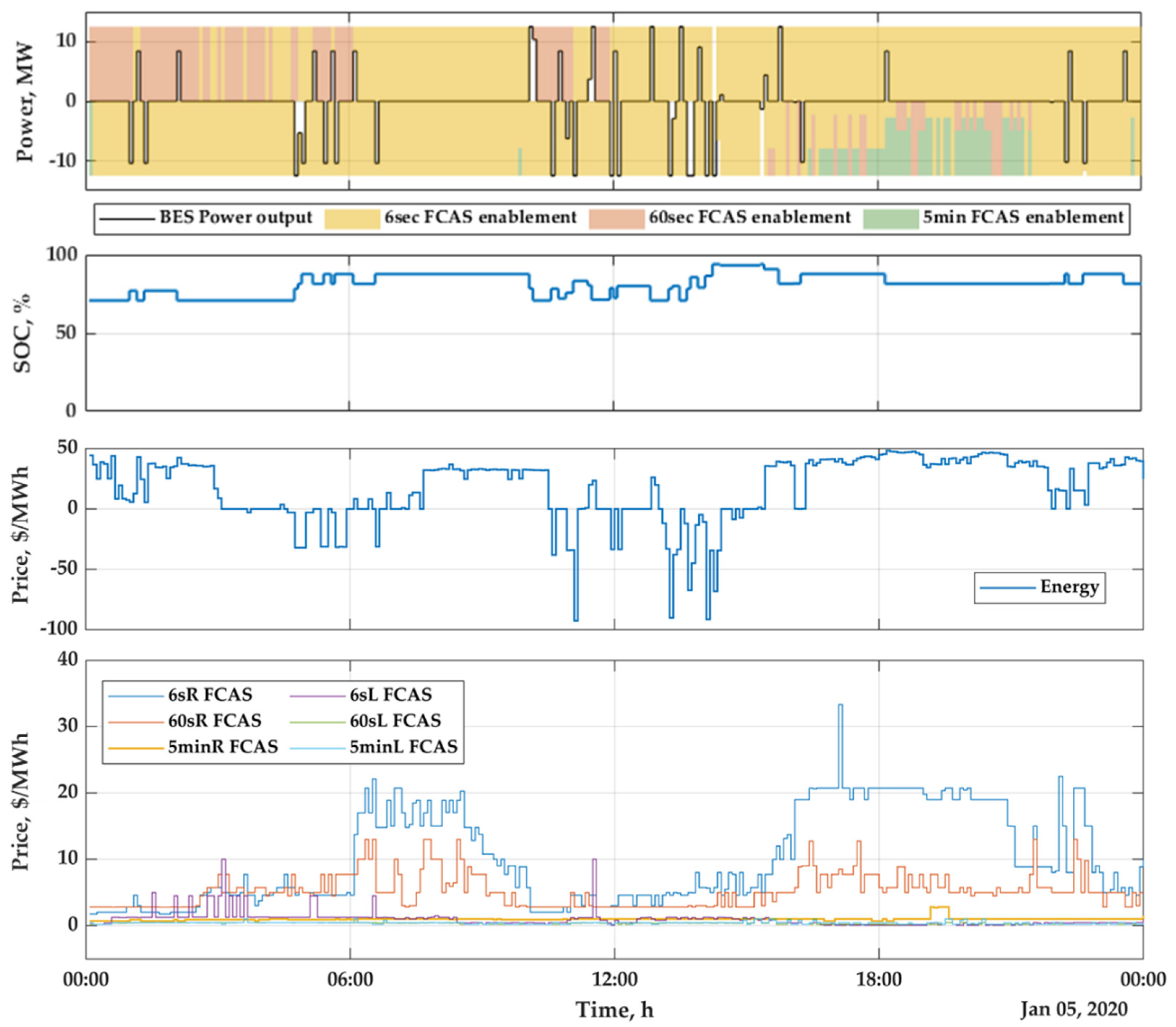

| Year 2020 | Tasmania | South Australia | Victoria | New South Wales | Queensland |
|---|---|---|---|---|---|
| Population (M) | 0.5 | 1.7 | 6.4 | 7.5 | 5.1 |
| Solar PV | 2% | 17% | 8% | 8% | 13% |
| Wind | 14% | 42% | 14% | 6% | 2% |
| Hydro | 83% | - | 5% | 3% | 1% |
| Gas | 1% | 42% | 3% | 2% | 11% |
| Coal | - | - | 74% | 73% | 80% |
| Imports | 12% | 7% | 3% | 8% | - |
| Exports | 12% | 8% | 7% | 0% | 7% |
| Renewables share | 99% | 59% | 27% | 18% | 16% |
| Price $/MWh | 43 | 43 | 61 | 68 | 43 |
| FCAS Type | FCAS Name | Function | General Description |
|---|---|---|---|
| Regulation | Raise | Correct minor drop in frequency | Designed to respond to small deviation in the frequency (up to ±0.15 Hz). The control is implemented using utomatic generator control (AGC). Units on regulation duties have to continuously adjust their operational set points, injecting more or less active power depending on control signals provided by AEMO. |
| Lower | Correct minor raise in frequency | ||
| Contingency | Fast raise | Provides an active power response within 6 s after frequency deviates away from normal operating band (NOB). It must be sustained for 60 s | Designed to respond to contingency events when frequency deviates away from normal operating band (NOB). No contingency response is provided if frequency stays within NOB (49.85–51.15 Hz) |
| Fast lower | |||
| Slow raise | Provides an active power response within 60 s after frequency deviates away from NOB. It must be sustained for 300 s | ||
| Slow lower | |||
| Delayed raise | Provides an active power response within 5 min after frequency deviates away from NOB. It must be sustained for 600 s | ||
| Delayed lower |
| Parameter | Value |
|---|---|
| Nominal capacity | 12.5 MWh/12.5MW |
| Charging/discharging power rating | 1C |
| Maximum SOC | 95% |
| Minimum SOC | 15% |
| Charging/discharging efficiency | 90% |
| Battery cycle life | 3000 cycles at 80% DOD 22,0000 cycles at 30% DOD |
| Battery shelf life () | 10 years |
| Cell temperature | Maintained at 25 °C |
| Battery-pack replacement cost | 380,000 AUD/MWh |
| Chemistry | Li(NiMnCo)O2 lithium-ion |
| Strategy 1 | Strategy 2 | Strategy 3 | |
|---|---|---|---|
| Participation in the energy market | Y | Y | Y |
| Participation in FCAS market | N | Y | Y |
| Cycling degradation costs constraint | N | N | Y |
| Strategy 1 | Strategy 2 | Strategy 3 | |
|---|---|---|---|
| Revenue from the energy market | $1,585,793 | $1,450,624 | $1,217,395 |
| Revenue from FCAS market | $0.0 | $1,492,116 | $1,598,569 |
| Gross revenue | $1,585,793 | $2,942,740 | $2,815,964 |
| Battery cycling costs | $1,445,615 | $1,007,162 | $57,514 |
| Benefit after costs | $140,178 | $1,935,578 | $2,758,450 |
| Annual cycling degradation | 30.43% | 21.20% | 1.21% |
| Equivalent cycles (@80%DOD) | 913.6 | 636.5 | 36.3 |
| Battery life expectancy (years) | 3.29 | 4.72 | 10.00 |
Publisher’s Note: MDPI stays neutral with regard to jurisdictional claims in published maps and institutional affiliations. |
© 2021 by the authors. Licensee MDPI, Basel, Switzerland. This article is an open access article distributed under the terms and conditions of the Creative Commons Attribution (CC BY) license (https://creativecommons.org/licenses/by/4.0/).
Share and Cite
Bayborodina, E.; Negnevitsky, M.; Franklin, E.; Washusen, A. Grid-Scale Battery Energy Storage Operation in Australian Electricity Spot and Contingency Reserve Markets. Energies 2021, 14, 8069. https://doi.org/10.3390/en14238069
Bayborodina E, Negnevitsky M, Franklin E, Washusen A. Grid-Scale Battery Energy Storage Operation in Australian Electricity Spot and Contingency Reserve Markets. Energies. 2021; 14(23):8069. https://doi.org/10.3390/en14238069
Chicago/Turabian StyleBayborodina, Ekaterina, Michael Negnevitsky, Evan Franklin, and Alison Washusen. 2021. "Grid-Scale Battery Energy Storage Operation in Australian Electricity Spot and Contingency Reserve Markets" Energies 14, no. 23: 8069. https://doi.org/10.3390/en14238069







